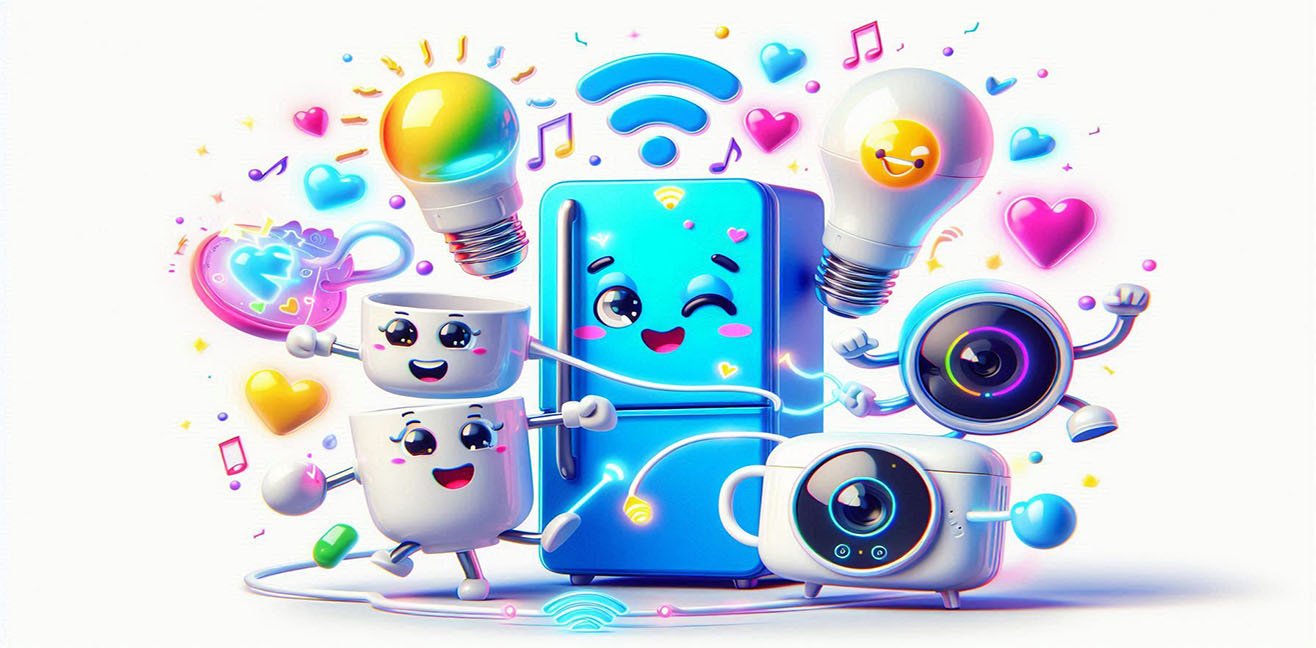Once upon a time, devices were silent, my love…
TVs were just for watching, refrigerators just cooled, watches just told time.
But then something happened…
🌩️ The internet arrived, and everything started talking!
Now your fridge can text you saying “we’re out of eggs, my love 🥚”,
and cars seem to have their own WhatsApp group: “Traffic jam bro, I’ll be 10 minutes late 🚗💬”.
This revolution is called: Internet of Things (IoT).
💡 What is IoT? (Short Definition, Deep Meaning)
IoT is physical devices connecting to the internet to collect data, share it, and communicate with each other.
Imagine an ecosystem made of sensors, microcontrollers, Wi-Fi modules, and cloud computing.
🧠 With a simple equation:
IoT = Sensor + Internet + Cloud + Data Analysis + Decision
Thanks to this system:
Smart homes wake us up with morning coffee ☕
Cities optimize traffic lights automatically 🚦
Agricultural fields are efficiently irrigated with sensors 🌾
And factories predict their own malfunctions 🔧
🧩 Basic Components of IoT
Every “smart” device has several fundamental building blocks at its heart. Let’s look at them in order, my love:
1️⃣ Sensors (Devices That Learn to Hear)
Sensors are like tiny spies collecting data from the environment.
📍 Examples:
Temperature sensor (DHT11, DHT22)
Motion sensor (PIR)
Distance sensor (Ultrasonic HC-SR04)
Gas sensor (MQ2)
🎯 Purpose: “To get data from the real world”.
2️⃣ Microcontroller / Edge Device
This small brain processes data from the sensor.
Most popular examples:
Arduino UNO / Nano (for simple projects 💡)
ESP8266 / ESP32 (Wi-Fi enabled, stars of IoT projects 🌟)
Raspberry Pi (more powerful, like a mini computer 🍓)
These devices collect data from sensors, analyze it, and send it to the internet.
3️⃣ Communication Protocols
If you ask “how do IoT devices talk?”, my love, the answer is here 👇
📡 Most popular communication protocols:
Wi-Fi: Great for home projects.
Bluetooth Low Energy (BLE): Low energy consumption, short distance.
Zigbee / Z-Wave: Kings of smart home systems 👑
LoRaWAN: For long-distance sensor networks (e.g., in agriculture).
MQTT: The “WhatsApp” of IoT – devices send/receive messages.
4️⃣ Cloud (The Cloud)
Data from devices is stored and analyzed here.
☁️ Common platforms:
AWS IoT Core
Google Cloud IoT
Microsoft Azure IoT Hub
Blynk (super easy for small projects 🧸)
5️⃣ Application Layer
This is the interface we see as users.
For example:
The smart home app on your phone talks to that huge system on your behalf.
🧠 Practical IoT Project: “Smart LED Control Game” 🎮
Now we’ve come to the sweetest part, my love – coding time! 😍
With this little game, we’ll see how IoT works in action.
🎯 Goal:
To turn an LED on and off from your phone or computer!
That is, we’ll control a physical object over the internet.
🧰 Required Materials:
1x ESP8266 NodeMCU (or ESP32)
1x LED
1x 220Ω resistor
Breadboard + jumper cables
Wi-Fi connection
Blynk or Arduino IDE
💻 Code (for Arduino IDE)
#define BLYNK_TEMPLATE_ID “TMPLxxxxxx”
#define BLYNK_AUTH_TOKEN “your_token”
#define BLYNK_PRINT Serial
#include <ESP8266WiFi.h>
#include <BlynkSimpleEsp8266.h>
char auth[] = BLYNK_AUTH_TOKEN;
char ssid[] = “Your_WiFi_Name”;
char pass[] = “Your_WiFi_Password”;
int ledPin = D2;
void setup() {
Serial.begin(9600);
Blynk.begin(auth, ssid, pass);
pinMode(ledPin, OUTPUT);
}
BLYNK_WRITE(V1) {
int pinValue = param.asInt();
digitalWrite(ledPin, pinValue);
Serial.println(pinValue ? “💡 LED ON” : “🌑 LED OFF”);
}
void loop() {
Blynk.run();
}
💡 How it works?
1️⃣ Log into the Blynk app on your phone.
2️⃣ Create a button and connect it to V1 pin.
3️⃣ Press “Play” → Now you can turn the LED on and off remotely! 🚀
🎮 Bonus game:
Compete with a friend – whoever turns the LED on at the right time buys coffee ☕😆
🧠 Tips for IoT Developers
💡 1. Filter data: Sensors produce noisy data. Take averages or use thresholds.
💡 2. Security:
Don’t write Wi-Fi passwords plainly in code!
Use SSL/TLS (e.g., HTTPS or MQTTS).
💡 3. Energy saving: Use deep sleep mode for battery-operated devices.
💡 4. Learn OTA (Over-The-Air) updates – update code without physically touching the device!
💡 5. Edge Computing: Don’t send everything to the cloud; do small analyses on the device.
🌍 Looking to the Future: The Evolution of IoT
AI + IoT = AIoT: Devices won’t just collect data; they’ll make their own decisions too.
The rise of 5G: Low latency, faster connection = real-time data heaven.
Wearable technology: Watches, glasses, clothing… all “smart”.
Autonomous systems: Smart cities, smart factories, smart… everything!
🚨 Security Note:
Security is IoT’s biggest weakness.
Every device connected to the internet opens a new door for a hacker.
🔒 So:
Change default passwords.
Do regular updates.
Set up a firewall that monitors network traffic.
💬 Final Word:
IoT is a digital ecosystem wrapping the world in sensors.
Now homes, cars, factories, even fields are talking.
But my love…
Remember:
“As objects get smarter, people must become more conscious too.” 🧠💫
And always remember:
Trust your fridge, but never trust an unsecured Wi-Fi! 😎🔐




